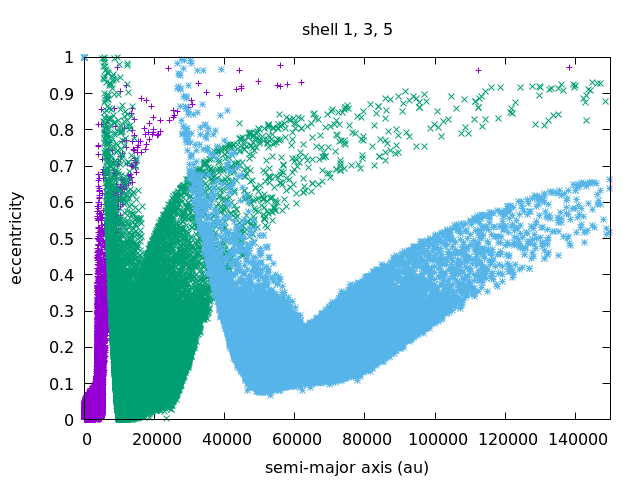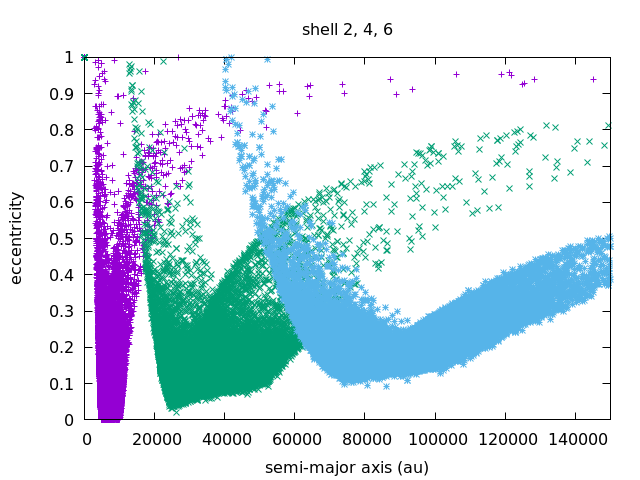Dynamical Evolution of TNOs after a stellar encounter
- University of Vienna, Astrophysics, Vienna, Austria (elke.pilat-lohinger@univie.ac.at)
Abstract
In this numerical study we show the effect of the stellar encounter of Gliese 710 on comets moving outside Neptune’s orbit. Depending on the distance of the stellar passage our study indicates the orbital changes of 54 – 180 million comets. To study such a huge amount of cometary orbits we split the area from 35 au to 100000 au into six shells consisting of 9 - 30 million small bodies each. After the stellar passage, the perturbations are clearly visible in the semi-major axis – eccentricity plane of the cometary reservoir. Each shell shows a “V-type” structure indicating a branch of inward moving objects and an outward directed branch that may create interstellar objects.
Introduction
Recent observations showed that the Sun will experience a close fly-by of the K-type star Gliese 710 in about 1.36 Myrs. It has been shown that Gliese 710 will cross the Oort cloud at a distance between ~4300 and ~12000 au (Berski and Dybczynski 2016; Bailer-Jones et al. 2018; De la Fuente Marcos and De la Fuente Marcos 2018). When crossing the cometary reservoir of the solar system the K-type star with 0.6 solar mass will scatter comets on high eccentricity orbits.
Motivated by this observation we studied the influence of this stellar fly-by for different distances of the stellar passage i.e., at 4000 au, 8000 au, and 12000 au using N-body simulations (Pilat-Lohinger et al. 2022, Loibnegger et al. 2022). The comets were distributed randomly in the various shells. They show the strongest perturbations for objects close to the trajectory of Gliese 710. Moreover, comets with semi-major axes smaller than the fly-by distance remain unaffected.
Numerical Set-up and Method
Using the recently developed GPU based N-body code of M. Zimmermann (2021) we studied up to 180 million testparticles in the outer solar system. The comets were distributed in different “layers” around the Sun and the 4 giant planets: A flat disk from 35 to 5000 au (i < 1°), a flared disk from (5000 to 10000 au (i < 45°) and a spherical cloud between 10000 and 100000 au (0° < i < 180°). Initial eccentricities of the comets were always less than 0.1. The fly-by time of Gliese 710 is about 20000 yrs, where we used the velocity of a K-type star from Rickman et al. (2008).
Results
Our simulations of the stellar fly-by show a “V-type” structure in the (a,e)-plot of the comets as displayed in Figs. 1 and 2 for the different shells. Thus, the passage of a star creates two branches of comets: an inward pointing branch which may transport comets towards the inner solar system and an outward pointing branch which may create interstellar objects. Note that the inward pointing branch indicates higher eccentricities than the outward pointing branch, especially in the shells of the spherical cloud.


More details of this study will be published soon.
Acknowledgements
This research was funded in whole by the Austrian Science Fund (FWF) [P33351-N]. The simulations were performed on the VSC3 and VSC4 (projects 71637 and 71686).
References
Bailer-Jones, C.A.L et al., 2018, A&A, 616,A37
Berski F. & Dybczynski P.A., 2016, A&A, 595, L10
De la Fuente Marcos R. & De la Fuente Marcos C., 2018, Research Notes of the American Astronomical Society, 2,2,30
Loibnegger B. et al., 2022, Proceeding of IAU Symposium 364, in press
Pilat-Lohinger E. et al, 2022, Proceeding of IAU Symposium 364, in press
Rickman H. et al., 2008, CeMDA , 1405,8077
Zimmermann M., 2021, Master thesis, University of Vienna
How to cite: Pilat-Lohinger, E., Loibnegger, B., and Zimmermann, M.: Dynamical Evolution of TNOs after a stellar encounter, Europlanet Science Congress 2022, Granada, Spain, 18–23 Sep 2022, EPSC2022-1165, https://doi.org/10.5194/epsc2022-1165, 2022.

